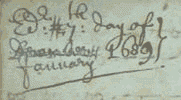Is the word abbreviated?
Abbreviations such as Ms., Mrs., Mr. Dr are widely used today. Before 1750, many more are found; the vestiges of a widespread medieval system of abbreviation.
Clerks usually drew the attention of the reader to an abbreviated word by one of several ways:
1. A short line, usually straight but sometimes curled, above the words concerned. This is called a tittle, and denotes a contraction: that is, letters missing from the middle of the word, such as in the word below: umquhile (meaning 'deceased'). In this case the clerk has written vmqle with a tittle above.
![the word vmq[uhi]le showing the use of a short line to indicate a contraction](/sites/default/files/styles/maximum_size/public/2024-02/problemwords_5.gif?itok=Uf4Suos-)
The most frequently omitted letters are m and n, or er, so try inserting each of these first to make possible sense of the word. The word below is summa (the Latin word meaning 'total'). The clerk has written Suma with a curled tittle above the m.
![the word Sum[m]a with a curled tittle](/sites/default/files/styles/maximum_size/public/2024-02/problemwords_6.gif?itok=74G2WQXo)
2. A flourish after a letter, usually the last letter in a word. The word below is Testament, but it has been abbreviated to Test and the clerk has made a mark of suspension after the last letter.
![tthe word Test[ament] using a mark of suspension to indicate a contraction](/sites/default/files/styles/maximum_size/public/2024-02/problemwords_7.gif?itok=PK7le1s5)
The phrase below is hir said spous, but the clerk has contracted the word said to just sd, and has made the d loop backwards to cross the s.
![the phrase his s[ai]d spous showing said contracted to sd](/sites/default/files/styles/maximum_size/public/2024-02/problemwords_8.gif?itok=ZaVub1N_)
3. A superscript letter - usually the last letter. A word was often abbreviated by writing the first few letters then the last letter (or a letter near the end of the word) superscript. For example, the word Edinburgh was frequently abbreviated this way to Edr. The example below reads Edr. 7th day of January 1689.

4. A special letter or symbol. The ampersand (&) is the special symbol indicating the word and. It was in use since medieval times and derives from the Latin word et meaning and. By the eighteenth century it is common to find it written like the modern typescript version. But this form was in use much earlier, as the example below (from the mid-seventeenth century) shows:
A simpler form, and one widely used in sixteenth, sevententh and eighteenth century texts consists of a curl with a small head (see example below).

Depending how clearly this is written it can easily be confused with the letters x, p, or the secretary hand h. The ampersand is one of those letters or symbols which suffer from the idiosyncracies of the writer, especially an elaborate writer. The example below required at least four strokes of the pen:

Look out for abbreviations for the prefixes con- or com- in sixteenth and seventeenth century Scottish documents. There were two common ways of making such an abbreviation. Firstly, a contraction mark could be written in the form of a loop running up from the letter o, as in the word co[m]mand, in the image below.
When written clearly this is not hard to detect, but if written sloppily, makes for difficult reading. In the word co[n]vene below, the o is not well formed and the contraction mark interferes with the letter c.
The second way of abbreviating the prefix con- was to use a special symbol, which is easily confused with the letter g or q. In the word [con]stitut below, the symbol for con looks very like g.
![the word [con]stitut written with a symbol for the contraction con-](/sites/default/files/styles/maximum_size/public/2024-02/co_contraction_03.gif?itok=Kyq4Evf_)
Use of the symbol for con was prevalent in legal records, especially in abbreviating Latin terms. The image below is from the margin of a burgh court book, and gives the name of the parties in the case: Dalrymple [con]tra Stevine
![the words Dalrymple [con]tra Stevine written with a symbol for the contraction con-](/sites/default/files/styles/maximum_size/public/2024-02/co_contraction_04.gif?itok=K0snohKj)
If this hasn’t solved the problem try another option:
Phonetic spelling
Scots, legal and Latin words
Sums of money
Dates
Return to the problem words page.